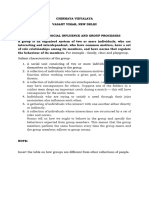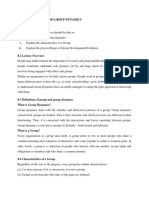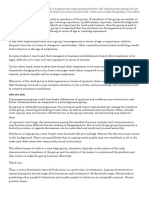0 ratings0% found this document useful (0 votes)
27 viewsGroup Formation and Development
Uploaded by
Fitha FathimaCopyright
© © All Rights Reserved
Available Formats
Download as PDF, TXT or read online on Scribd
0 ratings0% found this document useful (0 votes)
27 viewsGroup Formation and Development
Uploaded by
Fitha FathimaCopyright
© © All Rights Reserved
Available Formats
Download as PDF, TXT or read online on Scribd
You are on page 1/ 26
A group is two or more individuals,
interacting and interdependent, who have
come together to achieve particular
objectives.
formal group
informal group
People often feel strongly about their groups partly because,
shared experiences amplify our perception of events
Social identity theory proposes that people have emotional
reactions to the failure or success of their group because their
self-esteem gets tied to whatever happens to the group.
When your group does well, you bask in reflected glory, and your
own self-esteem rises. When your group does poorly, you might
feel bad about yourself, or you might reject that part of your
identity
if your group is devalued and disrespected, your social identity
might feel threatened, and you might endorse deviant behaviors
to “get even” and restore your group’s standing.
Social identities can even lead people to experience pleasure as a
result of seeing another group suffer.
Ingroup favoritism occurs when we see
members of our group as better than other
people, and people not in our group as all the
same.
Ingroups and outgroups pave the way for
social identity threat, which is akin to
stereotype threat.
With social identity threat, individuals believe
they will be personally negatively evaluated
due to their association with a devalued
group, and they may lose confidence and
performance effectiveness.
Temporary groups with finite deadlines pass
through a unique sequencing of actions
(1) Their first meeting sets the group’s direction,
(2) the first phase of group activity is one of
inertia and thus slower progress,
(3) a transition takes place exactly when the
group has used up half its allotted time,
(4) this transition initiates major changes,
(5) a second phase of inertia follows
the transition, and
(6) the group’s last meeting is characterized by
markedlyaccelerated activity
Workgroups shape members’ behavior, and
they also help explain individual behavior as
well as the performance of the group itself.
Roles
norms,
status,
size,
cohesiveness,
diversity
all group members are actors, each playing a
role, a set of expected behavior patterns
attributed to someone occupying a given
position in a social unit. We are required to
play a number of diverse roles, both on and
off our jobs. Different groups impose
different role requirements on individuals
role Perception-how we’re supposed to act in
a given situation is a role perception
Role expectations are the way others believe
you should act in a given context
When compliance with one role requirement
may make it difficult to comply with another,
the result is role conflict- when the
expectations of our different, separate
groups are in opposition
role Play and Assimilation
All groups have established norms—acceptable
standards of behavior shared by members that
express what they ought and ought not to do
under certain circumstances.
When agreed to by the group, norms influence
behavior with a minimum of external controls.
Norms and emotions
frequent communication can increase the power
of norms.
the normative effect of groups can powerfully
influence group attitudes and outcomes.
Norms and Conformity
As a member of a group, you desire acceptance
by the group. Thus, you are susceptible to
conforming to group norms.
Norms and behavior
norms in the workplace significantly influence
employee behavior.
Positive Norms and Group Outcomes
if employees aligned their thinking with positive
norms, these norms would become stronger and
the probability of positive impact would grow
exponentially.
Negative Norms and Group Outcomes
Status—a socially defined position or rank given to groups
or group members by others—permeates every society
What determines status? According to status
characteristics theory, status tends to derive from one of
three sources:
1. The power a person wields over others. Because they
likely control the group’s resources, people who control
group outcomes tend to be perceived as high status.
2. A person’s ability to contribute to a group’s goals.
People whose contributions are critical to the group’s
success tend to have high status.
3. An individual’s personal characteristics. Someone whose
personal characteristics are positively valued by the group
(good looks, intelligence, money, or a friendly personality)
typically has higher status than someone with fewer valued
attributes
status and Norms
Status has some interesting effects on the power of
norms and pressures to conform. High-status
individuals may be more likely to deviate from norms
when they have low identification (social identity) with
the group.
status and Group Interaction People tend to become
more assertive when they seek to attain higher status
in a group. They speak out more often, criticize
more, state more commands, and interrupt others
more often. Lowerstatus members tend to participate
less actively in group discussions; when they possess
expertise and insights that could aid the group,
failure to fully utilize these members reduces the
group’s overall performance.
status Inequity It is important for group members
to believe the status hierarchy is equitable.
Perceived inequity creates disequilibrium, which
inspires various types of corrective behaviors.
Hierarchical groups can lead to resentment
among those at the lower end of the status
continuum.
status and stigmatization Although it’s clear that
your own status affects them way people perceive
you, the status of people with whom you are
affiliated can also affect others’ views of you.
Group status
Social loafing, the tendency for individuals to
expend less effort when working collectively than
when alone
When managers use collective work situations,
they must also be able to identify individual
efforts.
greater performance diversity creates greater
social loafing the longer a group is together,
which decreases satisfaction and performance.
Research indicates that the stronger an
individual’s work ethic is, the less likely that
person is to engage in social loafing
(1) set group goals, so the group has a
common purpose to strive toward;
(2) increase intergroup competition, which
focuses on the shared group outcome;
(3) engage in peer evaluations;
(4) select members who have high motivation
and prefer to work in groups;
(5) base group rewards in part on each
member’s unique contributions.
Groups differ in their cohesiveness—the
degree to which members are attracted to
each other and motivated to stay in the
group.
the members have spent a great deal of time
together, the group’s small size or purpose
facilitates high interaction, or external threats
have brought members close together.
Cohesiveness affects group productivity
cohesiveness and productivity depends on
the group’s performance- related norms.
1) Make the group smaller,
(2) encourage agreement with group goals,
(3) increase the time members spend
together,
(4) increase the group’s status and the
perceived difficulty of attaining membership,
(5) stimulate competition with other groups,
(6) give rewards to the group rather than to
individual members,
(7) physically isolate the group
The final property of groups we consider is
diversity in the group’s membership, or the
degree to which members of the group are
similar to, or different from, one another.
Diversity appears to increase group conflict,
especially in the early stages of a group’s tenure;
this often lowers group morale and raises
dropout rates.
groups in which members’ values or opinions
differ tend to experience more conflict, but
leaders who can get the group to focus on the
task at hand and encourage group learning are
able to reduce these conflicts and enhance
discussion of group issues
Surface-level diversity—in observable
characteristics such as national origin, race,
and gender—alerts people to possible
deep-level diversity—in underlying attitudes,
values, and opinions.
Groups versus the Individual
Groups generate more complete information
and knowledge. By aggregating the resources
of several individuals, groups bring more
input as well as heterogeneity into the
decision process. They offer increased
diversity of views. groups lead to increased
acceptance of a solution. Group members
who participate in making a decision are
more likely to enthusiastically support and
encourage others to accept it later.
time-consuming
Conformity pressures.
dominated by one or a few members
ambiguous responsibility
Group decisions are generally more accurate
than the decisions of the average individual in
a group, but less accurate than the
judgments of the most accurate person.
In terms of speed, individuals are superior.
If creativity is important, groups tend to be
more effective.
And if effectiveness means the degree of
acceptance of achievable solutions,the nod
again goes to the group.
With few exceptions, group decision making
consumes more work hours than having an
individual tackle the same problem.
The exceptions tend to be instances in which,
to achieve comparable quantities of diverse
input, the single decision maker must spend
a great deal of time reviewing files and
talking to other people
You might also like
- Atomic Habits - SuperSummary Study GuideNo ratings yetAtomic Habits - SuperSummary Study Guide64 pages
- CHAPTER 7 Social Influence and Group Processes100% (1)CHAPTER 7 Social Influence and Group Processes45 pages
- Session III - Foundations of Group BehaviorNo ratings yetSession III - Foundations of Group Behavior30 pages
- Chapter 9 Foundation of Group BehaviorsNo ratings yetChapter 9 Foundation of Group Behaviors65 pages
- CHAPTER 7- SOCIAL INFLUENCE AND GROUP PROCESSESNo ratings yetCHAPTER 7- SOCIAL INFLUENCE AND GROUP PROCESSES6 pages
- Group, Nature, Structure & Group DynamicsNo ratings yetGroup, Nature, Structure & Group Dynamics19 pages
- Social Influence and Group Processes: Indian School MuscatNo ratings yetSocial Influence and Group Processes: Indian School Muscat6 pages
- Chapter 4 - Foundations of Group BehaviorNo ratings yetChapter 4 - Foundations of Group Behavior7 pages
- CHAP 7 SOCIAL INFLUENCE AND GROUP PROCESSESNo ratings yetCHAP 7 SOCIAL INFLUENCE AND GROUP PROCESSES31 pages
- NOTES SOCIAL INFLUENCE AND GROUP PROCESSE1No ratings yetNOTES SOCIAL INFLUENCE AND GROUP PROCESSE19 pages
- Chapter 7 - Social Influence and Group Processes100% (1)Chapter 7 - Social Influence and Group Processes9 pages
- Module No. 008 Foundation of Group BehaviorNo ratings yetModule No. 008 Foundation of Group Behavior19 pages
- Defining and Classifying Groups: Characteristics That Make Social Identity Important To A PersonNo ratings yetDefining and Classifying Groups: Characteristics That Make Social Identity Important To A Person4 pages
- Group Property 3: Status: Rommel J. Agnes BSA-2-13No ratings yetGroup Property 3: Status: Rommel J. Agnes BSA-2-1314 pages
- Group Dynamics and Intergroup RelationsNo ratings yetGroup Dynamics and Intergroup Relations40 pages
- Bs Complete Notes Group Dynamics and Team BuildingNo ratings yetBs Complete Notes Group Dynamics and Team Building10 pages
- Chapter Review - Ch. 09 - Foundation of Group BehaviourNo ratings yetChapter Review - Ch. 09 - Foundation of Group Behaviour3 pages
- Foundations For Understanding ERP Systems: Enterprise Resource PlanningNo ratings yetFoundations For Understanding ERP Systems: Enterprise Resource Planning9 pages
- ASSIGNMENTHfinalfinal (AutoRecovered) (AutoRecovered) (AutoRecovered)No ratings yetASSIGNMENTHfinalfinal (AutoRecovered) (AutoRecovered) (AutoRecovered)46 pages
- 15 Idioms That Make You Sound Like A Native Speaker100% (1)15 Idioms That Make You Sound Like A Native Speaker4 pages
- (Surname) (First Name) (M.I) (Course & Yr.)No ratings yet(Surname) (First Name) (M.I) (Course & Yr.)8 pages
- Clothing-Terminology Conformity and IndividualityNo ratings yetClothing-Terminology Conformity and Individuality4 pages
- Characteristics Identified by Fichter (1977) :: Chapter 4 - HUMAN GROUPNo ratings yetCharacteristics Identified by Fichter (1977) :: Chapter 4 - HUMAN GROUP4 pages
- The Impact of Presentation Format, Task Assignment, and Prior Knowledge On Students' Comprehension of Multiple Online DocumentsNo ratings yetThe Impact of Presentation Format, Task Assignment, and Prior Knowledge On Students' Comprehension of Multiple Online Documents28 pages
- Instant download Social Psychology 12th Edition Myers Test Bank pdf all chapter100% (2)Instant download Social Psychology 12th Edition Myers Test Bank pdf all chapter52 pages
- Social Relationship in Middle and Late AdolescenceNo ratings yetSocial Relationship in Middle and Late Adolescence34 pages
- Chapter 8: Foundations of Group BehaviorNo ratings yetChapter 8: Foundations of Group Behavior28 pages
- (Psychology of Learning and Motivation 58) Brian H. Ross (Eds.) - Academic Press, Elsevier (2013)No ratings yet(Psychology of Learning and Motivation 58) Brian H. Ross (Eds.) - Academic Press, Elsevier (2013)283 pages
- June 2022 QP - Paper 2 AQA Psychology GCSENo ratings yetJune 2022 QP - Paper 2 AQA Psychology GCSE32 pages
- The Distribution of Rewards and Resources Groups and Organizations'No ratings yetThe Distribution of Rewards and Resources Groups and Organizations'41 pages
- Shaktiman Vartaman - The Power of Now in Hindi Hindi Edition Tolle Eckhart _ PDFNo ratings yetShaktiman Vartaman - The Power of Now in Hindi Hindi Edition Tolle Eckhart _ PDF291 pages
- Bandwagon and Reverse Bandwagon Effect - AdwaidNo ratings yetBandwagon and Reverse Bandwagon Effect - Adwaid6 pages
- Foundations of Group Behavior: Lecturer: Prof. Floor RinkNo ratings yetFoundations of Group Behavior: Lecturer: Prof. Floor Rink34 pages
- Organizational Behavior: Chapter 9 - Foundations of Group BehaviorNo ratings yetOrganizational Behavior: Chapter 9 - Foundations of Group Behavior10 pages
- Buy ebook Social psychology Fourteenth Edition David G. Myers cheap price100% (3)Buy ebook Social psychology Fourteenth Edition David G. Myers cheap price65 pages
- CBSE Class 12 Psychology NCERT Solutions Chapter-7 Social Influence and Group ProcessesNo ratings yetCBSE Class 12 Psychology NCERT Solutions Chapter-7 Social Influence and Group Processes9 pages
- Social Influence and Group Processes: Indian School MuscatSocial Influence and Group Processes: Indian School Muscat
- Defining and Classifying Groups: Characteristics That Make Social Identity Important To A PersonDefining and Classifying Groups: Characteristics That Make Social Identity Important To A Person
- Group Property 3: Status: Rommel J. Agnes BSA-2-13Group Property 3: Status: Rommel J. Agnes BSA-2-13
- Bs Complete Notes Group Dynamics and Team BuildingBs Complete Notes Group Dynamics and Team Building
- Chapter Review - Ch. 09 - Foundation of Group BehaviourChapter Review - Ch. 09 - Foundation of Group Behaviour
- Foundations For Understanding ERP Systems: Enterprise Resource PlanningFoundations For Understanding ERP Systems: Enterprise Resource Planning
- ASSIGNMENTHfinalfinal (AutoRecovered) (AutoRecovered) (AutoRecovered)ASSIGNMENTHfinalfinal (AutoRecovered) (AutoRecovered) (AutoRecovered)
- 15 Idioms That Make You Sound Like A Native Speaker15 Idioms That Make You Sound Like A Native Speaker
- Characteristics Identified by Fichter (1977) :: Chapter 4 - HUMAN GROUPCharacteristics Identified by Fichter (1977) :: Chapter 4 - HUMAN GROUP
- The Impact of Presentation Format, Task Assignment, and Prior Knowledge On Students' Comprehension of Multiple Online DocumentsThe Impact of Presentation Format, Task Assignment, and Prior Knowledge On Students' Comprehension of Multiple Online Documents
- Instant download Social Psychology 12th Edition Myers Test Bank pdf all chapterInstant download Social Psychology 12th Edition Myers Test Bank pdf all chapter
- Social Relationship in Middle and Late AdolescenceSocial Relationship in Middle and Late Adolescence
- (Psychology of Learning and Motivation 58) Brian H. Ross (Eds.) - Academic Press, Elsevier (2013)(Psychology of Learning and Motivation 58) Brian H. Ross (Eds.) - Academic Press, Elsevier (2013)
- The Distribution of Rewards and Resources Groups and Organizations'The Distribution of Rewards and Resources Groups and Organizations'
- Shaktiman Vartaman - The Power of Now in Hindi Hindi Edition Tolle Eckhart _ PDFShaktiman Vartaman - The Power of Now in Hindi Hindi Edition Tolle Eckhart _ PDF
- Foundations of Group Behavior: Lecturer: Prof. Floor RinkFoundations of Group Behavior: Lecturer: Prof. Floor Rink
- Organizational Behavior: Chapter 9 - Foundations of Group BehaviorOrganizational Behavior: Chapter 9 - Foundations of Group Behavior
- Buy ebook Social psychology Fourteenth Edition David G. Myers cheap priceBuy ebook Social psychology Fourteenth Edition David G. Myers cheap price
- CBSE Class 12 Psychology NCERT Solutions Chapter-7 Social Influence and Group ProcessesCBSE Class 12 Psychology NCERT Solutions Chapter-7 Social Influence and Group Processes










































































































